Our Ants

Stanley S. and Sydney R. Shuman Professor
Investigator, Howard Hughes Medical Institute
Investigator, Howard Hughes Medical Institute
This page mostly contains photographs of our main study system, the clonal raider ant Ooceraea biroi, as well as related species in the ant subfamily Dorylinae, including the infamous army ants. For photographs from the book “Army Ants: Nature’s Ultimate Social Hunters” (Harvard University Press, 2020), the respective figure numbers are given in the legends (in bold, and in no particular order).
All pictures on this page are copyright by Daniel Kronauer. They can be used for non-commercial purposes with proper attribution. Please contact me via email if you would like to use images for commercial purposes or require high resolution versions. Right click on images and open in new tab to enlarge.
Clonal Raider Ants
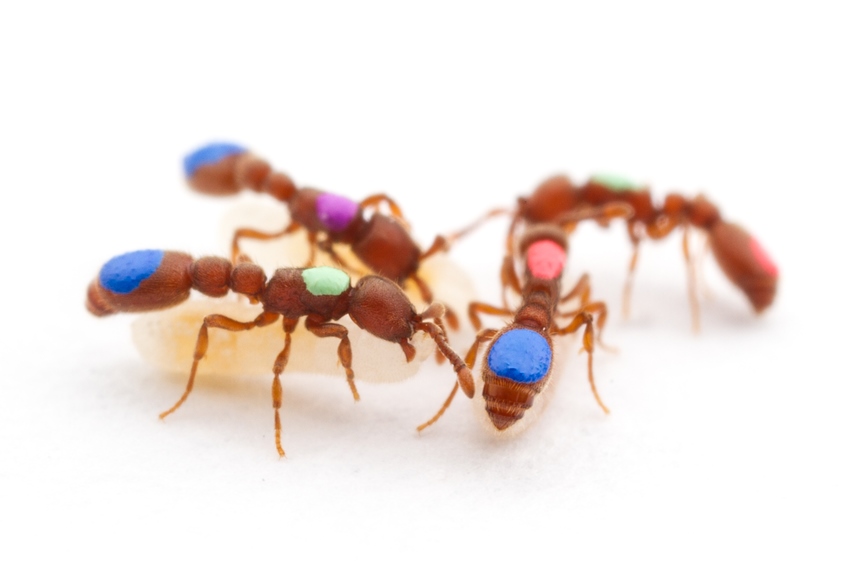 |
Clonal raider ant workers carrying larvae. The ants are individually tagged with unique combinations of color dots for behavioral tracking. Figure 2.24 |
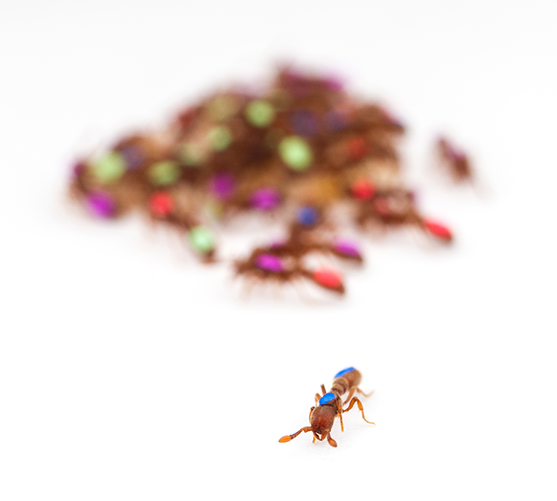 |
A laboratory colony of clonal raider ants. A lone ant is exploring the environment in the foreground, while the main nest cluster can be seen in the background. |
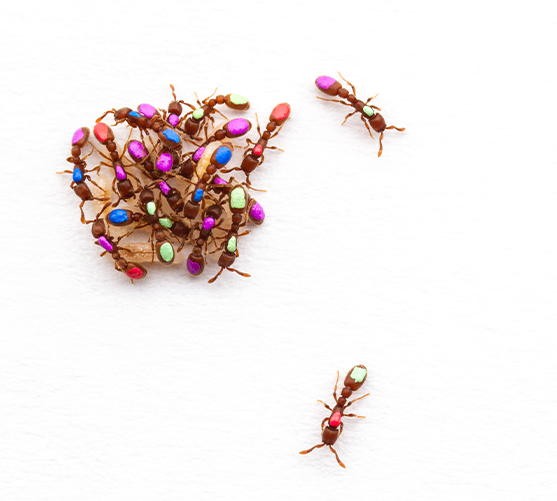 |
A laboratory colony of clonal raider ants seen from above. The ants form a main cluster around the larvae, while some ants leave the cluster to explore and forage. This colony is in the brood care phase of the colony cycle, during which ants forage and tend the larvae, but do not lay eggs. |
| Our lab has developed a series of setups for automated behavioral tracking. Based on the individual color tags described above, the setup in the picture allows us to track the behavior of individual ants in up to 140 colonies simultaneously. | |
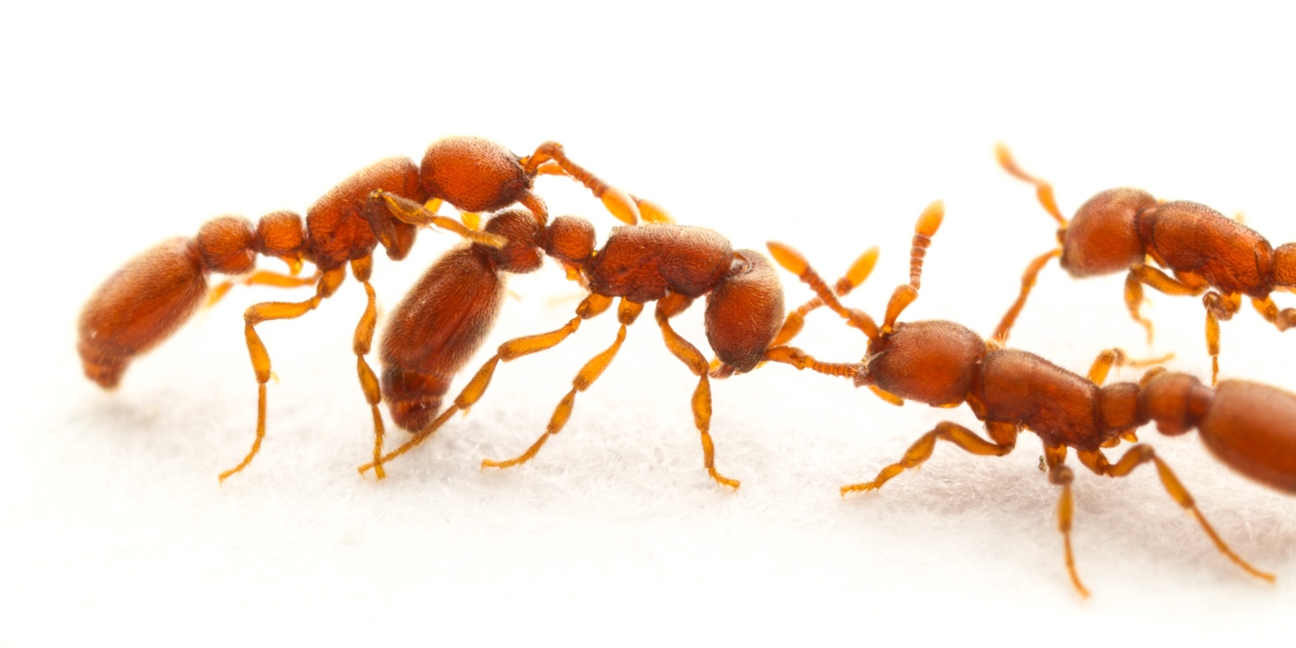 |
Clonal raider ants show aggressive behavior, for example towards intruders from foreign colonies (non-nestmate discrimination) or towards members of their own colony that become reproductively active out of sync with the rest of the colony (worker policing). |
Army Ants
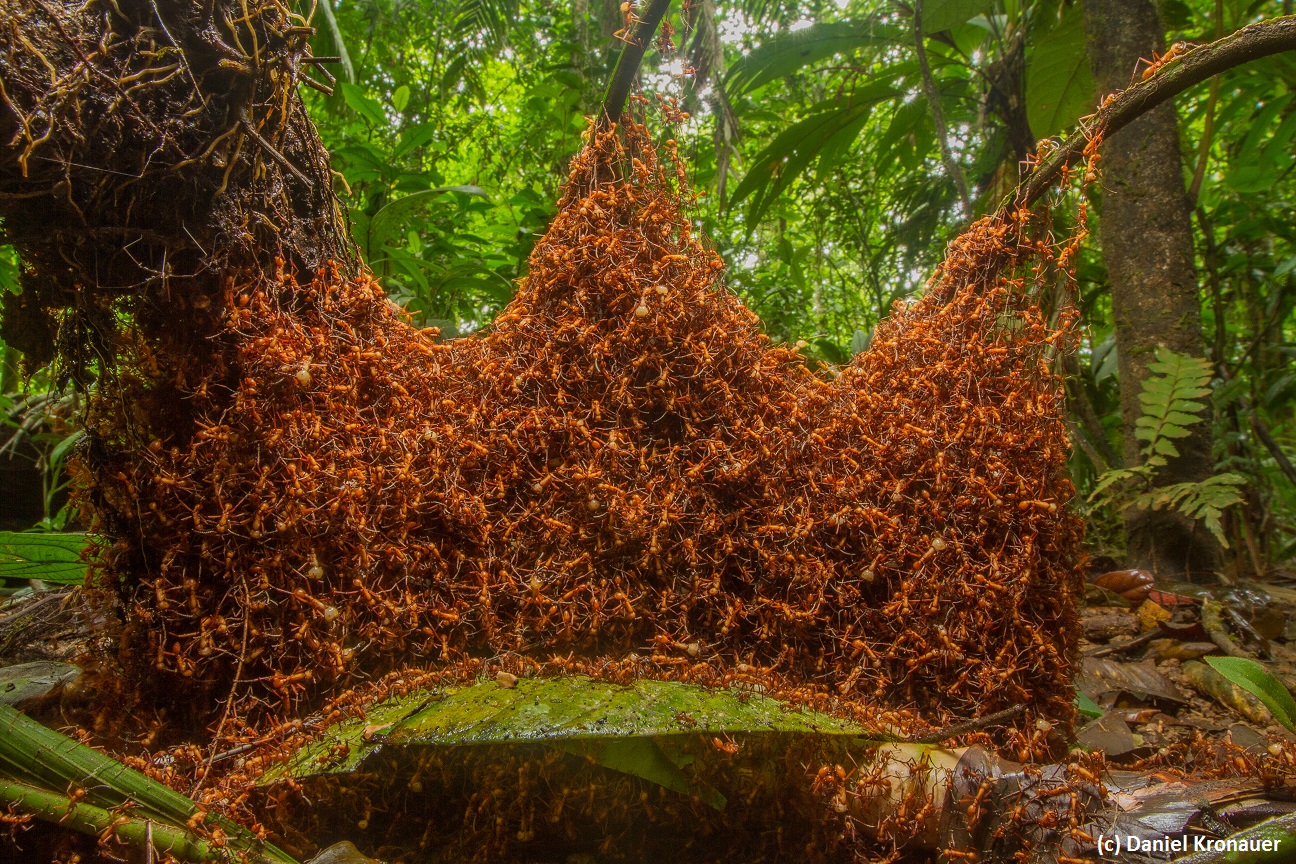 |
Army ants do not build permanent nests, but instead form so-called bivouacs, made up entirely of the live ants themselves. Bivouac nests of the species Eciton hamatum are sometimes constructed entirely in the open. This unusual bivouac resembles a cathedral with three naves. La Selva Biological Station, Costa Rica. Figure 4.16 |
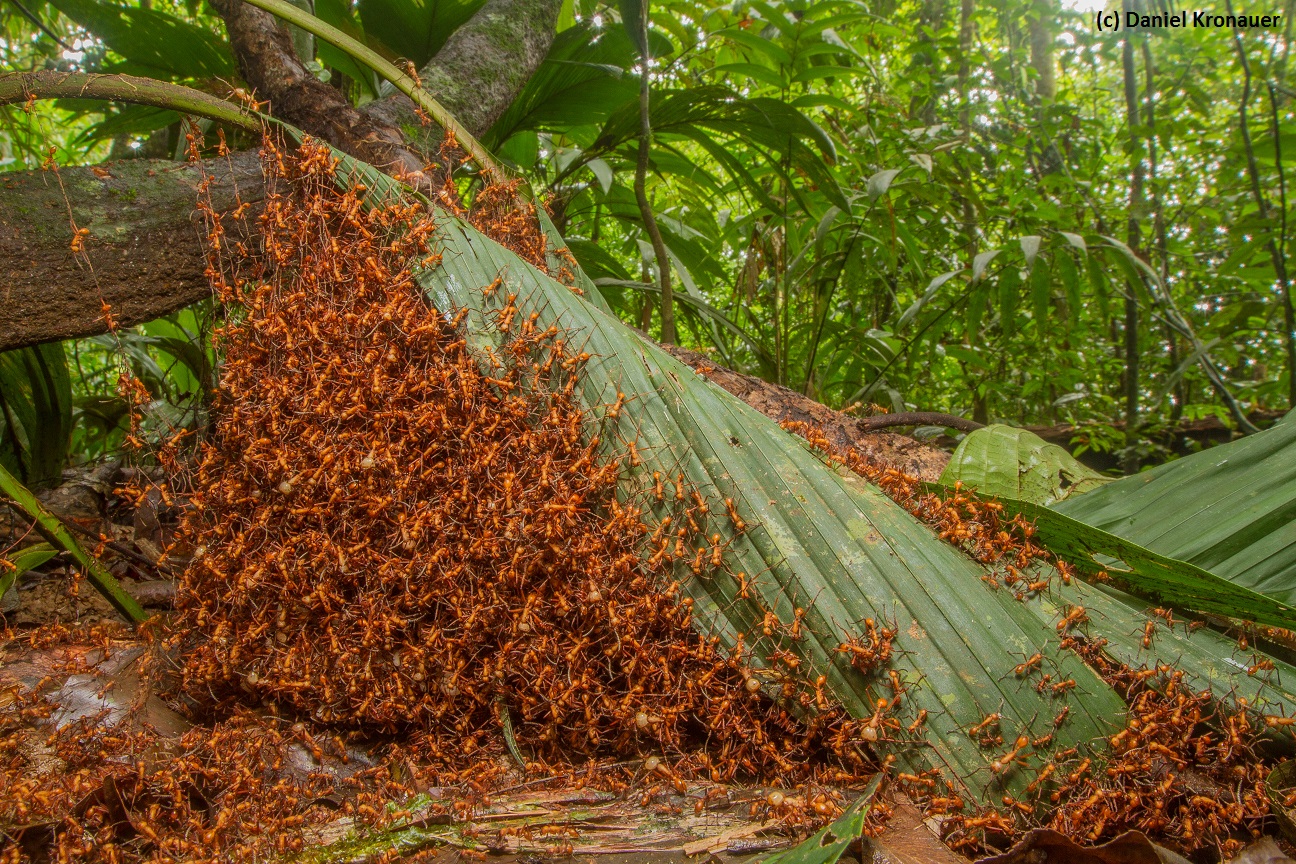 |
Here is a different view of the Eciton hamatum “cathedral” bivouac. La Selva Biological Station, Costa Rica. |
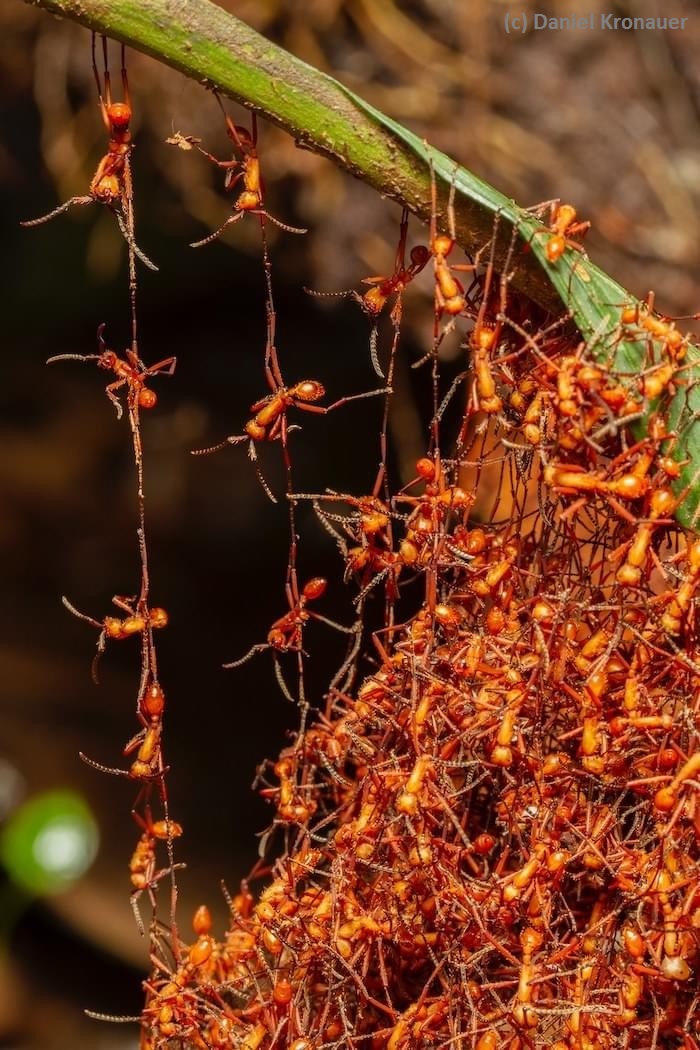 |
This closeup of an Eciton hamatum bivouac at La Selva Biological Station in Costa Rica shows how the ants assemble into the living chains that form the bivouac scaffold. Figure 4.19 |
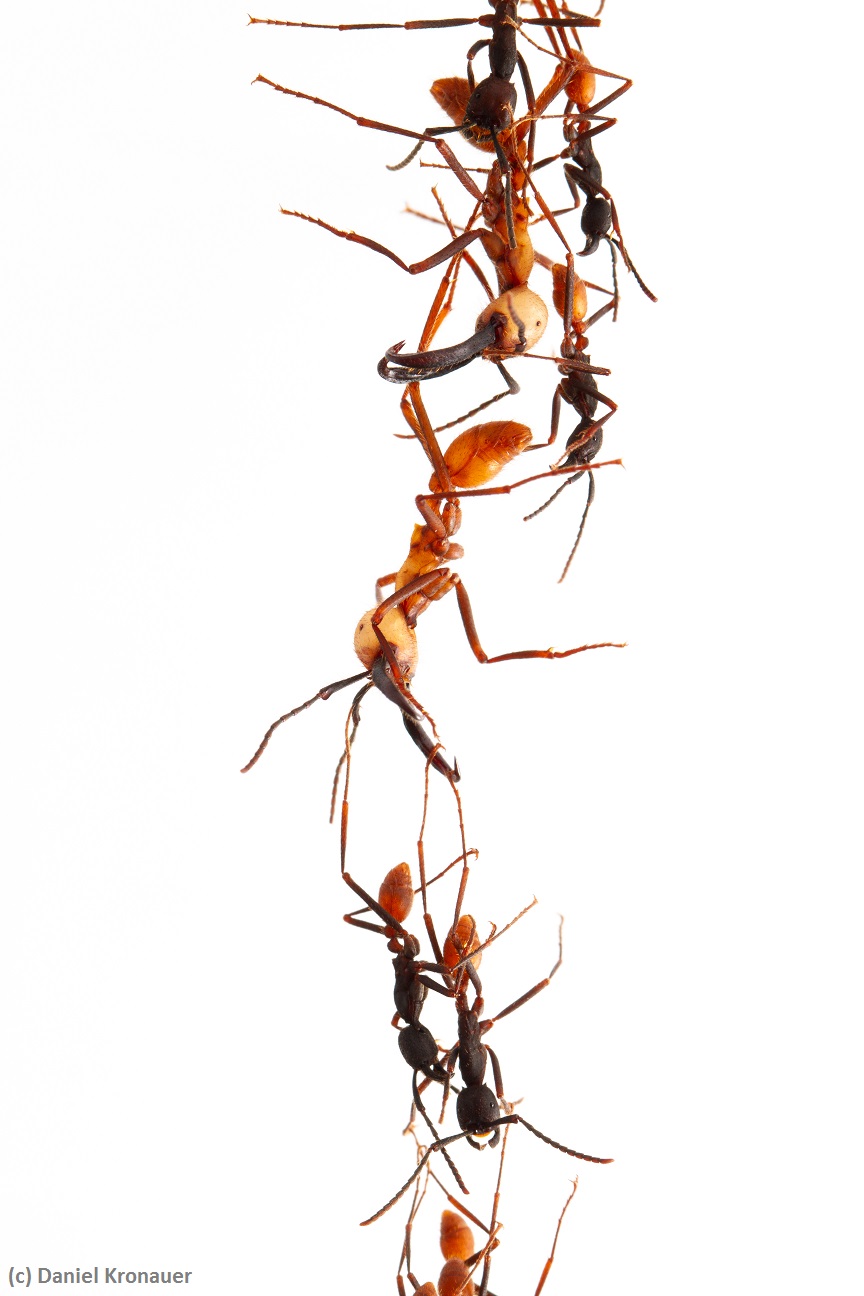 |
Army ants are masters of living architecture. The essential building blocks of their bridges and bivouac nests are chains that the ants form by clinging together with hooks on their feet. Here is a closeup of such a chain formed inside an experimental box in the lab. Eciton burchellii, La Selva Biological Station, Costa Rica. |
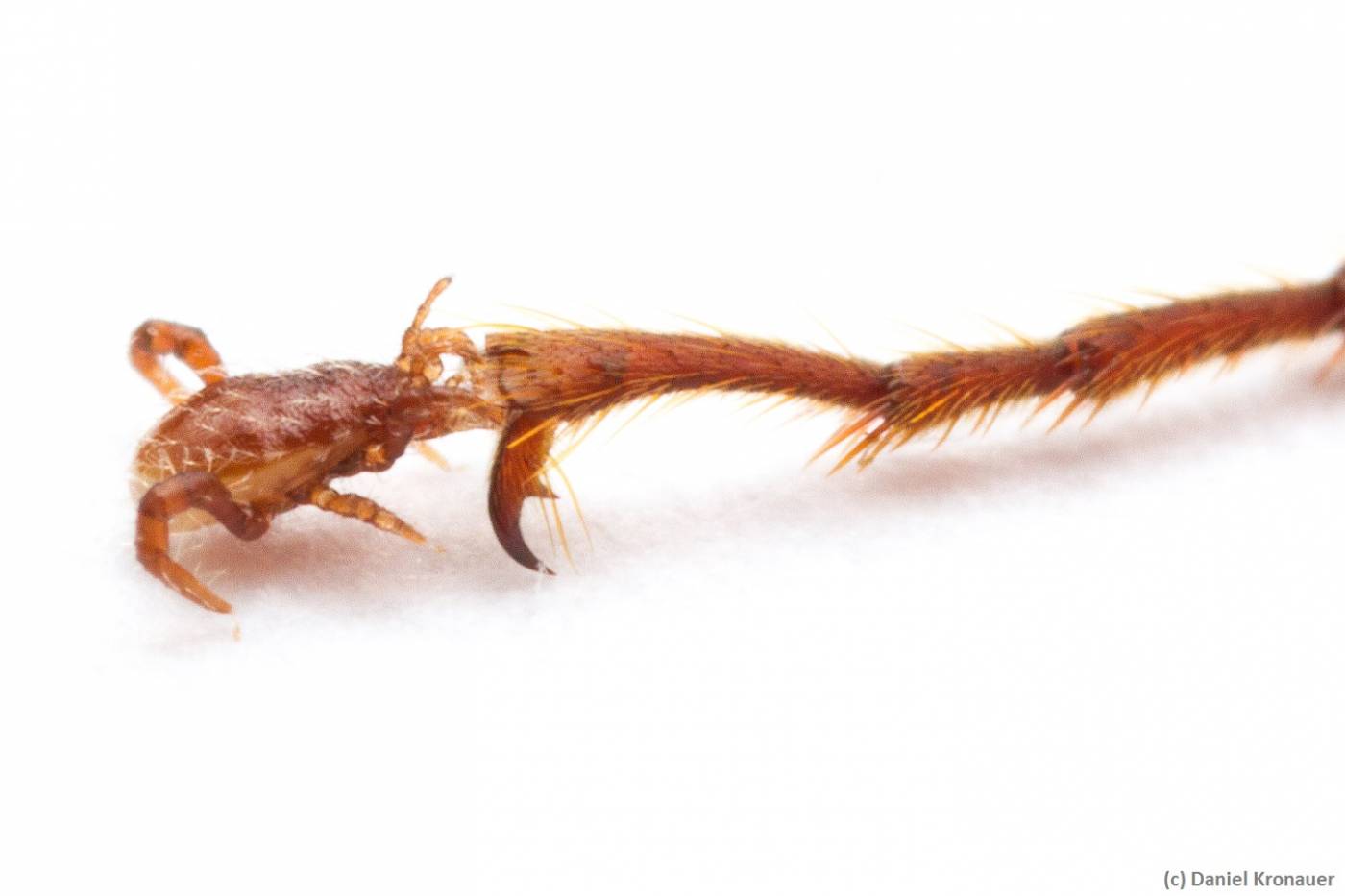 |
Macrocheles rettenmeyeri is arguably the most bizarre mite. It attaches to the ants’ feet to suck hemolymph. But its hind legs look like the ants’ tarsal claws, and take over their function when the ants form chains. The host ant is Eciton dulcium. La Selva Biological Station, Costa Rica. |
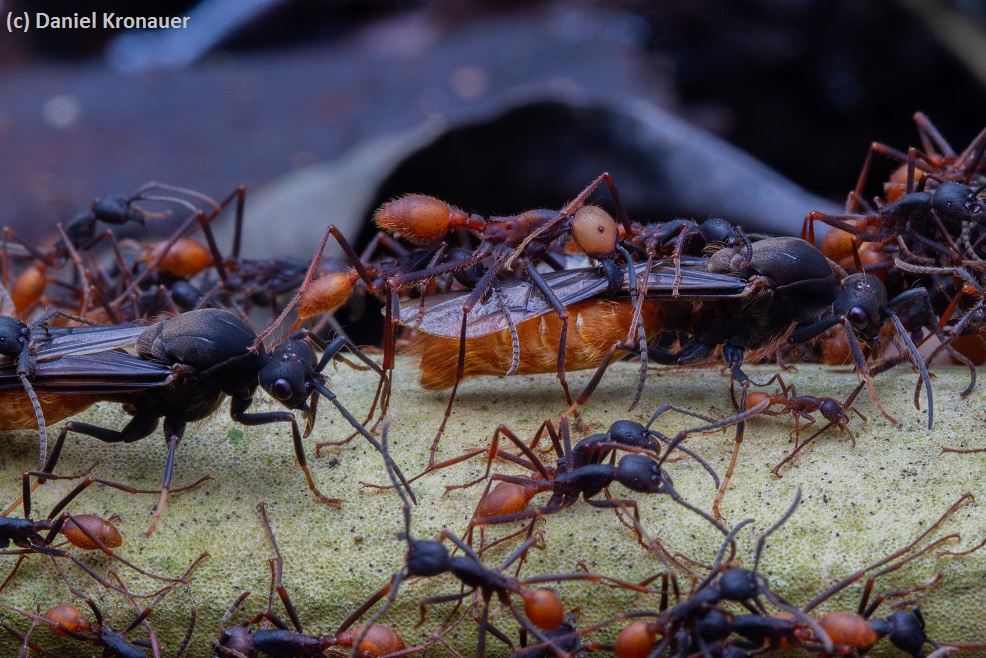 |
Newly eclosed Eciton burchellii males walking in the emigration column of their mother colony. A reproductive brood of army ants typically contains several thousand males and just a few young queens. The males disperse on the wing to mate. La Selva Biological Station, Costa Rica. |
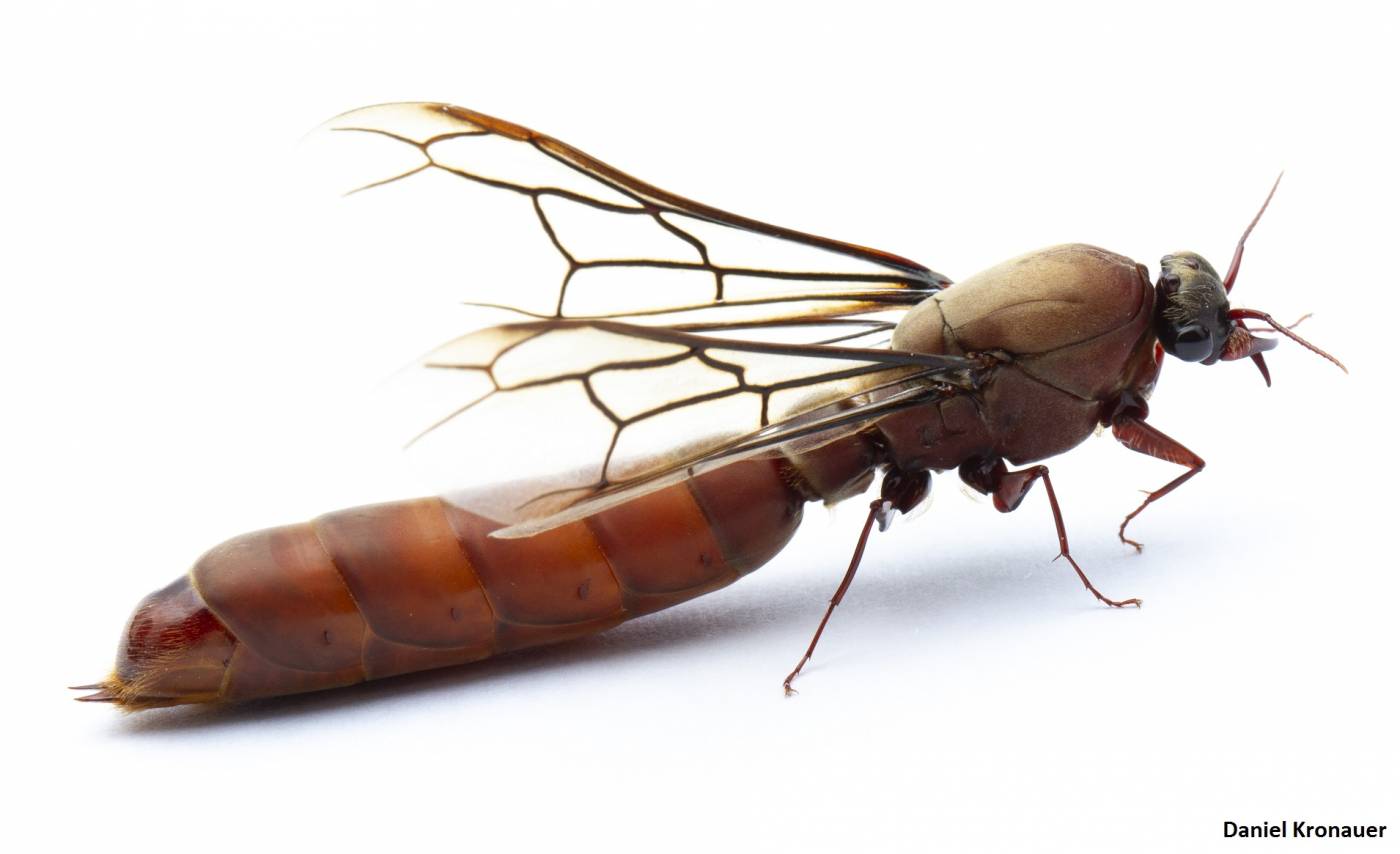 |
The males of Dorylus army ants are extremely large and beefy, which has earned them the name “sausage flies” throughout Africa. This Dorylus male of the subgenus Typhlopone appeared at a light at Mpala Research Centre in Kenya one evening. |
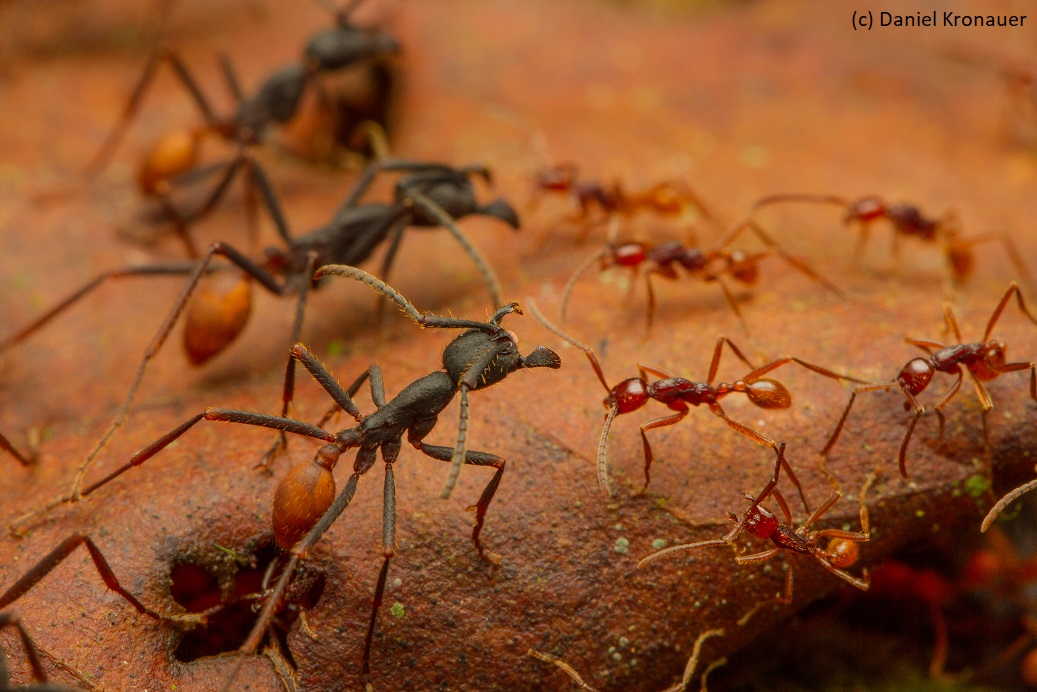 |
Encounters between different army ant colonies rarely escalate beyond the occasional scuffle. Instead, workers form a guard at trail intersections, facing each other one-to-one with their mandibles wide open, a sign of utter alertness. Eciton burchellii (left) vs. Neivamyrmex gibbatus (right) at La Selva Biological Station, Costa Rica. Figure 4.10 |
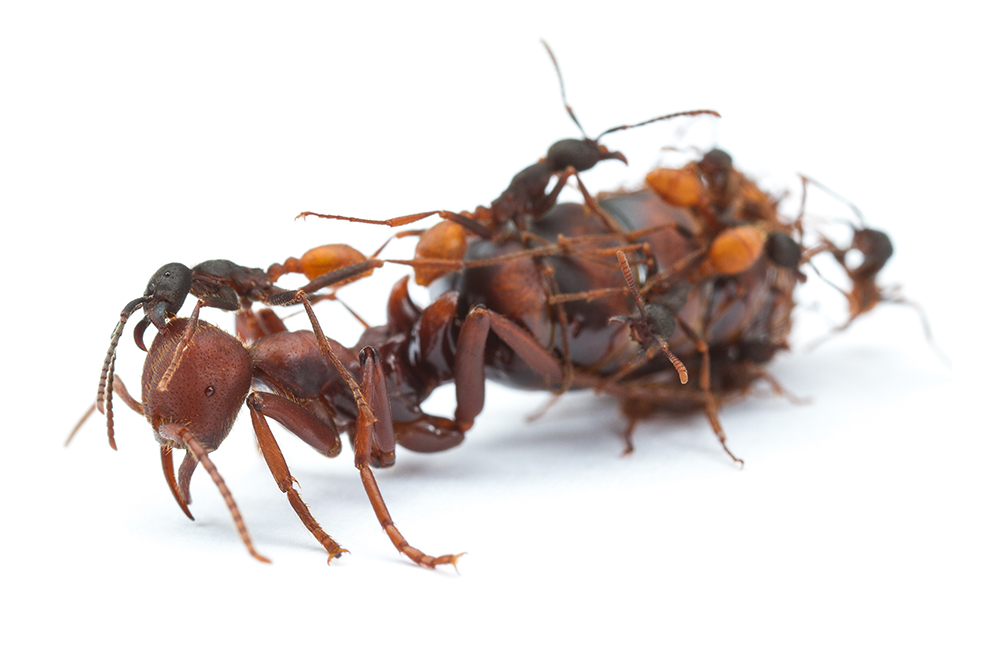 |
A queen of the army ant Eciton burchellii with some of her workers. Army ant queens are permanently wingless and never leave the colony. Large colonies reproduce by fission, and each daughter colony retains a single queen which mates inside the colony with ca. twenty males. La Selva Biological Station, Costa Rica. |
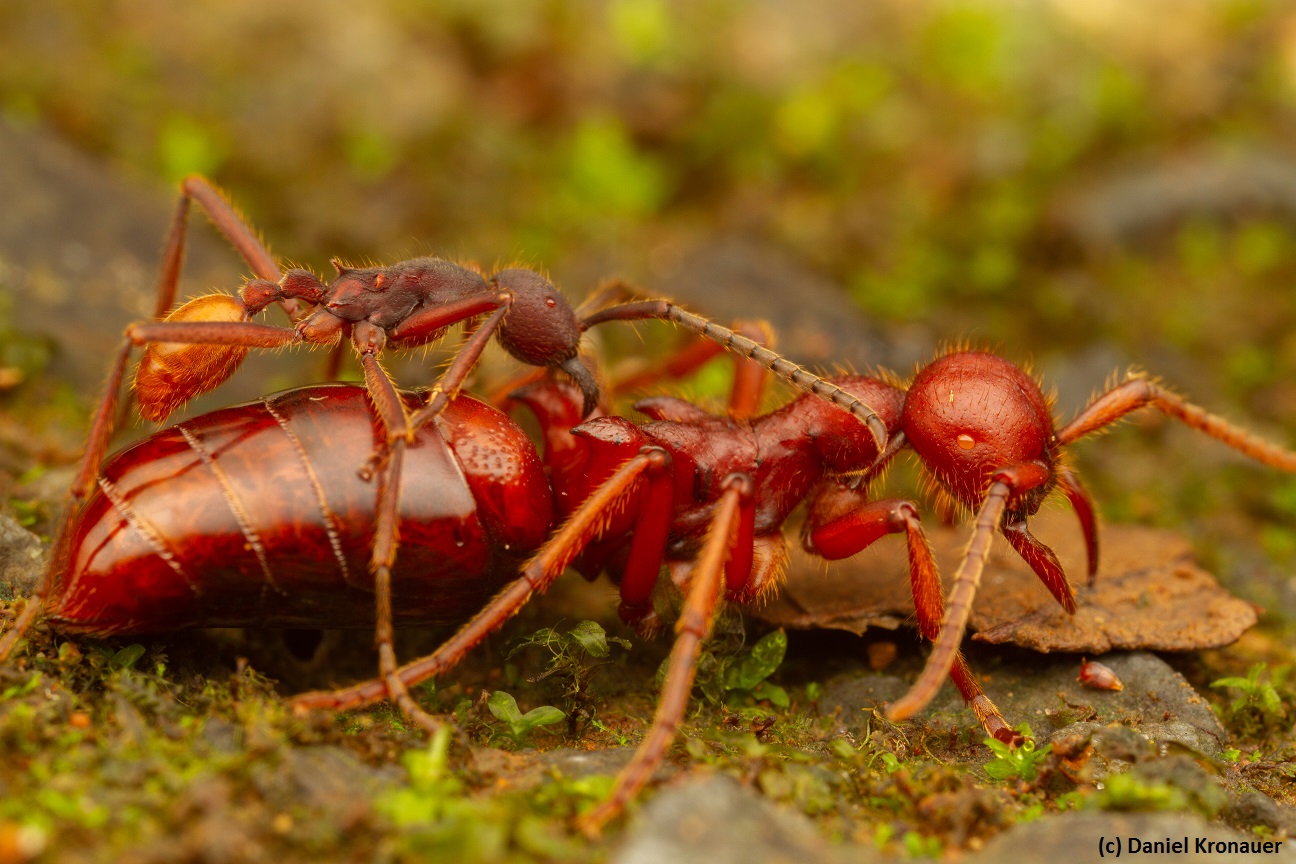 |
Another army ant monarch – the queen of Eciton vagans. La Selva Biological Station, Costa Rica. |
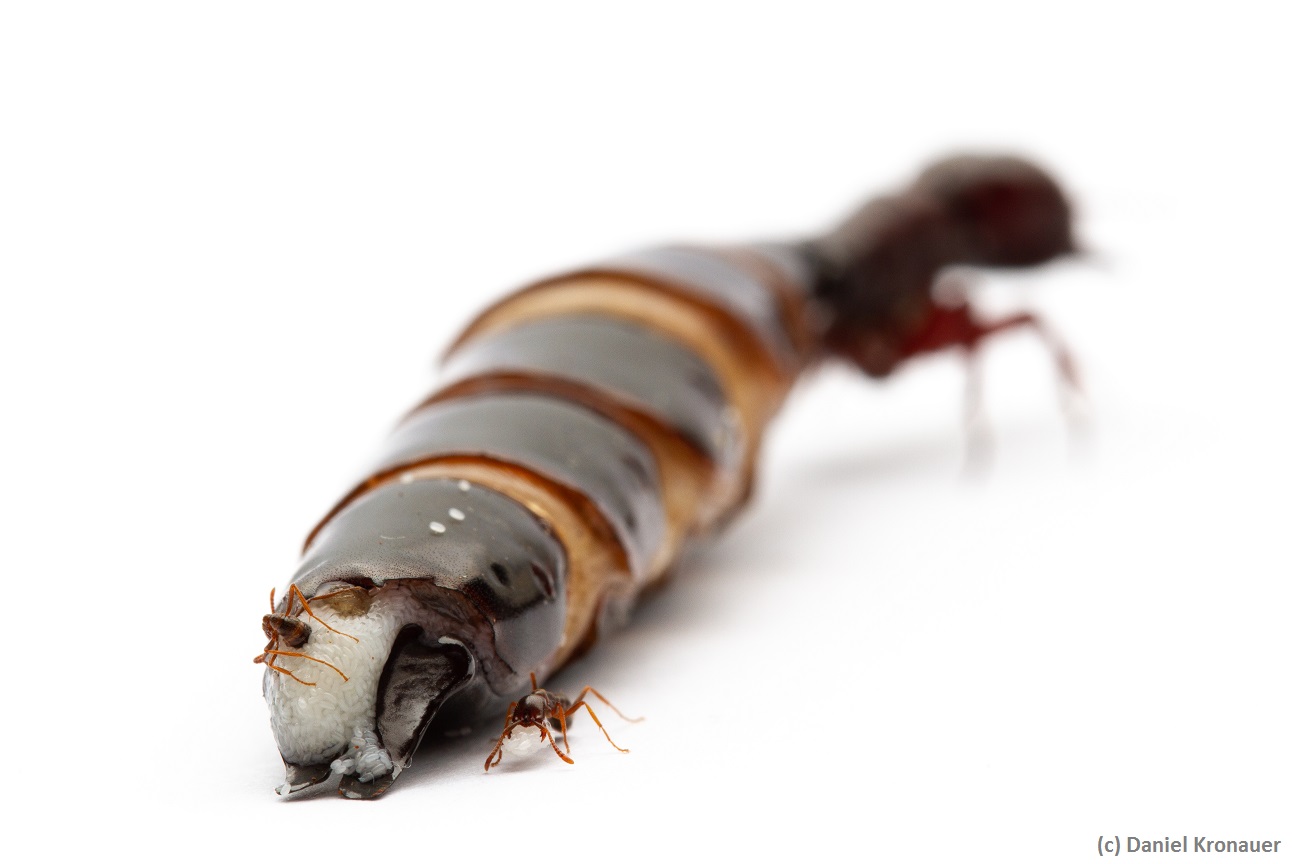 |
The massive African driver ant queens are arguably the most bizarre and largest of all ants. The white mass coming out of the queen’s rear end are eggs, and the worker ant on the right is carrying a clump of freshly laid eggs in her mandibles. Dorylus molestus at Mount Kenya, Kenya. |
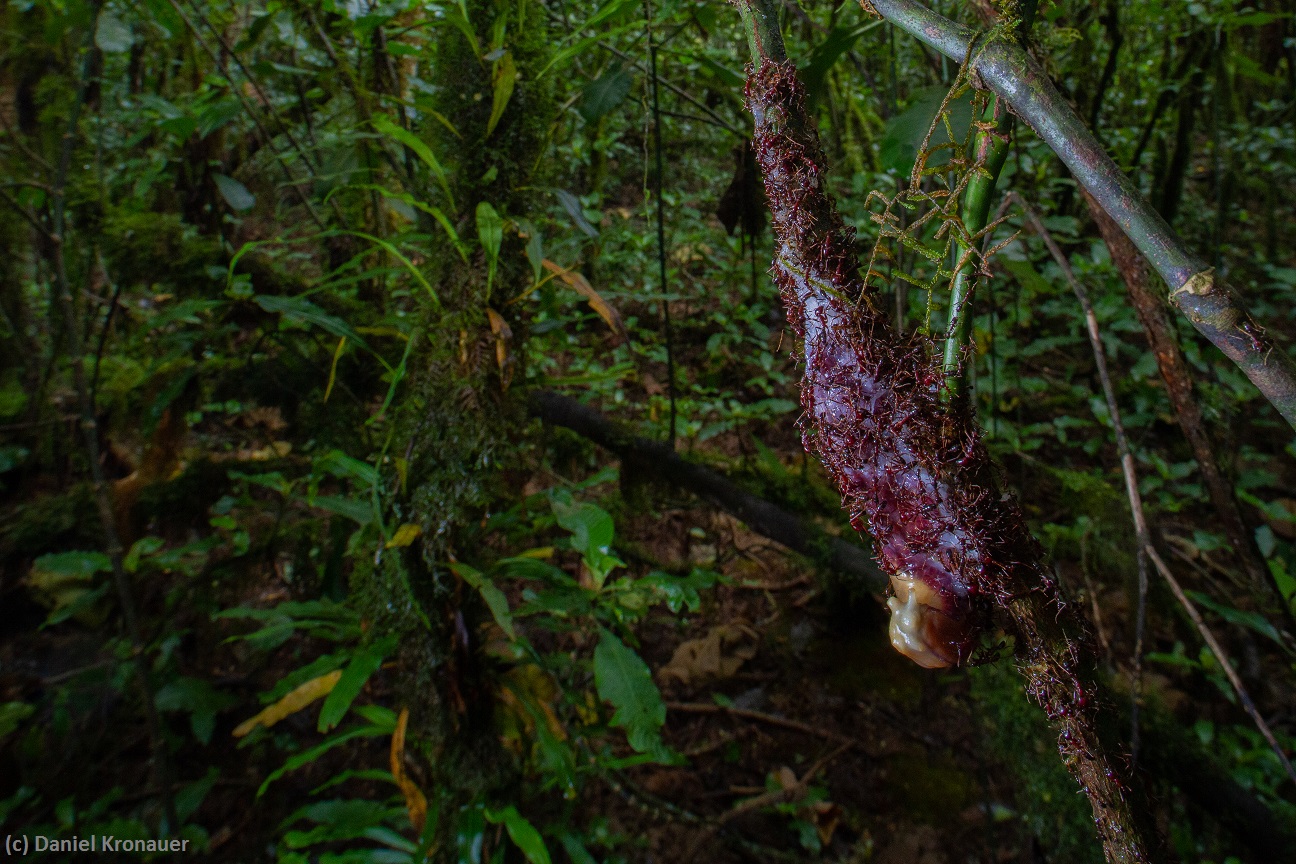 |
Driver ants (Dorylus molestus) attack a large slug at Mount Kenya. African driver ants are among the few army ants that ascend into the vegetation. |
 |
In army ant mass raids, many thousand ants go hunting together and overwhelm prey as they encounter it. A single raid can last for hours and retrieve tens of thousands of prey items. Here’s a snapshot: Eciton burchellii taking on a large katydid. La Selva Biological Station, Costa Rica. |
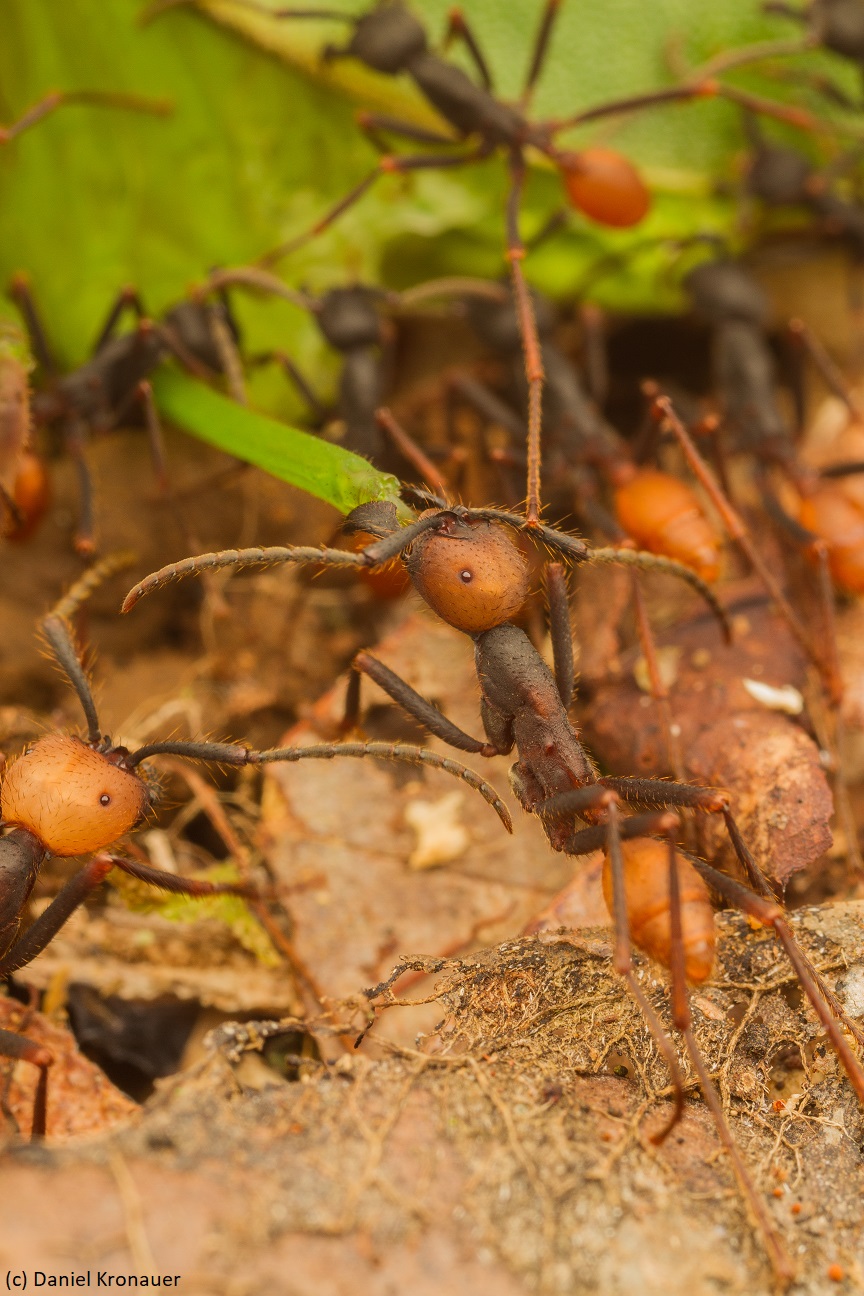 |
An Eciton burchellii carpet swarm can be over 15 meters wide and 2 meters deep. Here’s another angle of the scene depicted in the preceding image of the ants attacking a katydid. La Selva Biological Station, Costa Rica. |
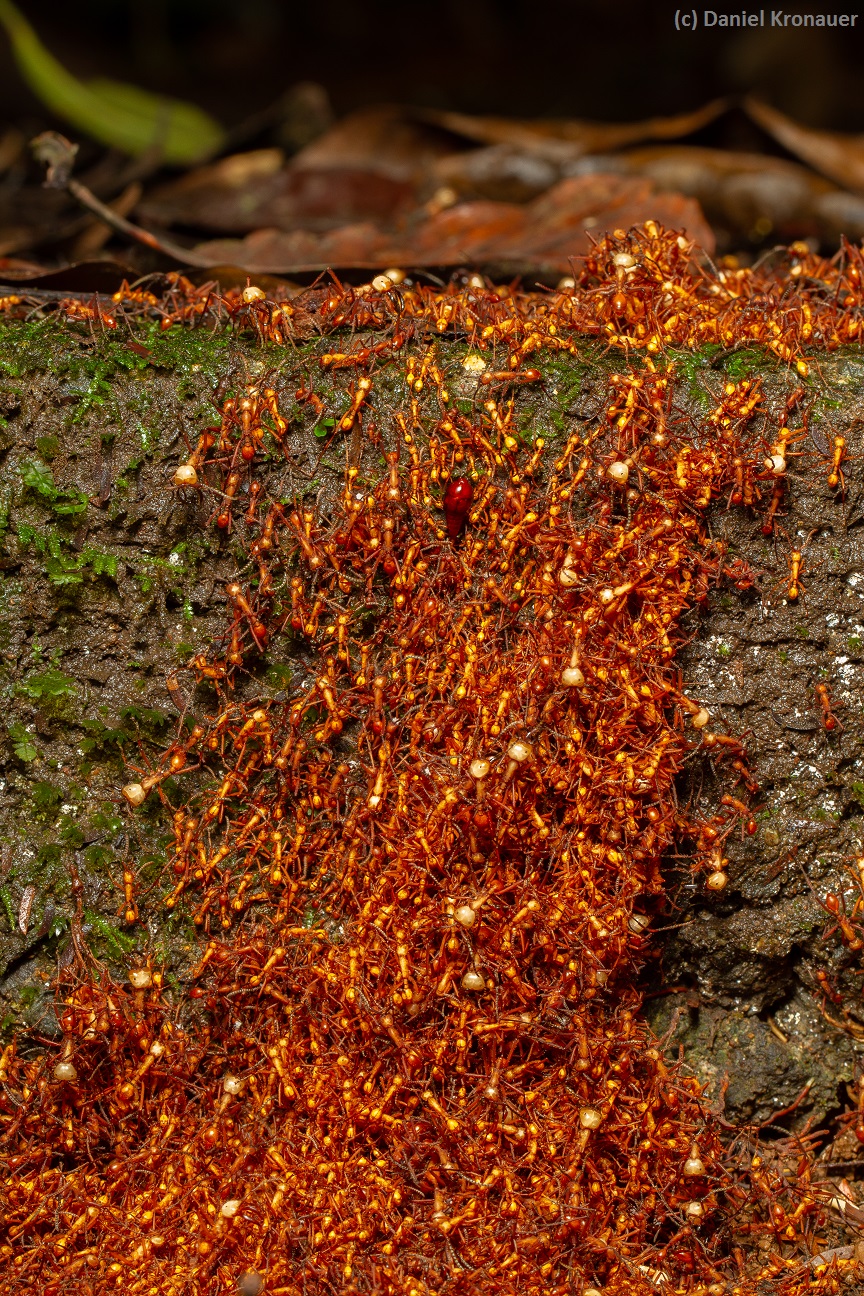 |
Eciton hamatum army ants storm an elevated concrete footpath at La Selva Biological Station, Costa Rica. A myrmecophilous rove beetle, Vatesus cf. clypeatus, is running among the mass of ants. The lifecycle of these beetles is highly synchronized with that of their hosts. |
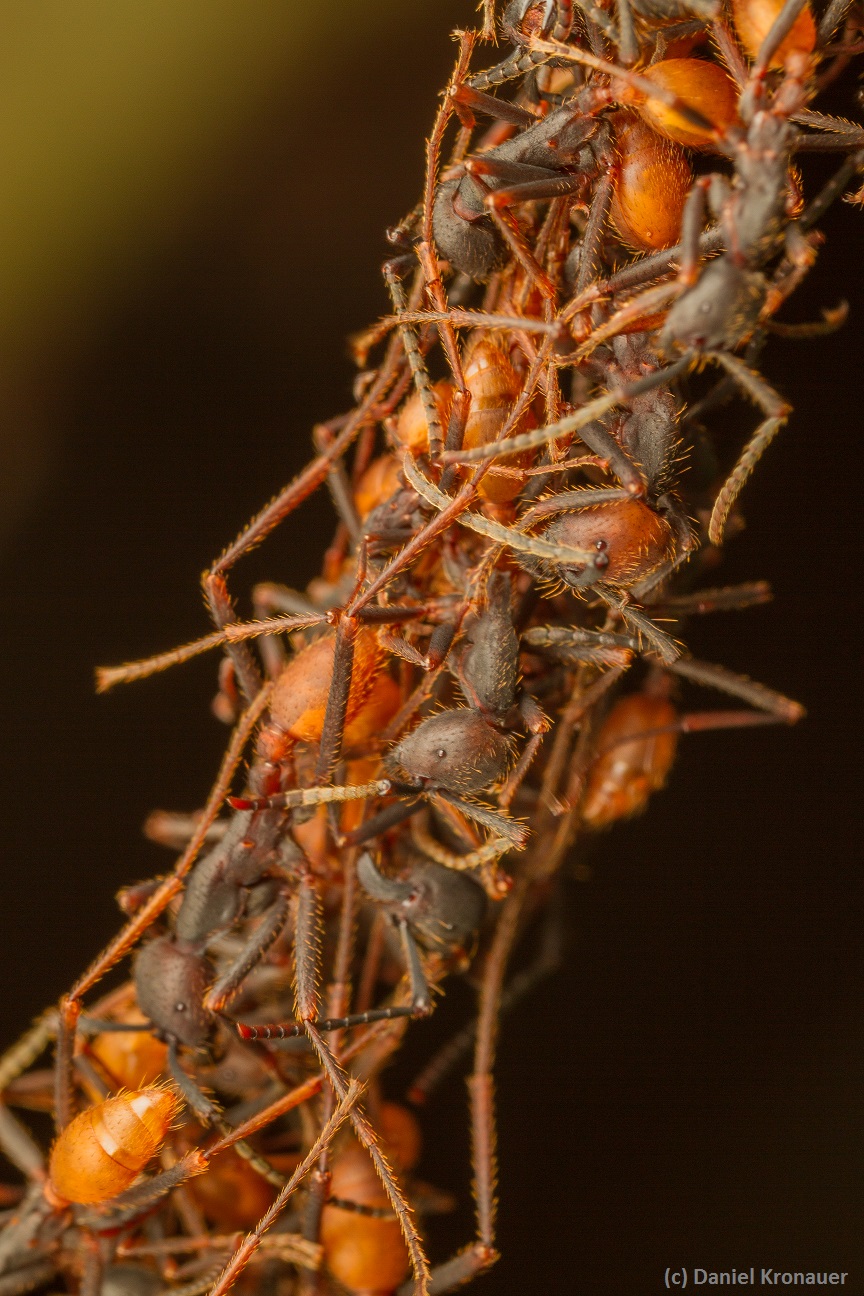 |
Army ant architecture depends heavily on traffic flow. The more ants are travelling across a bridge or flange, the more impressive the structure gets. This Eciton burchellii “chain” has turned into a thick “rope”. La Selva Biological Station, Costa Rica. |
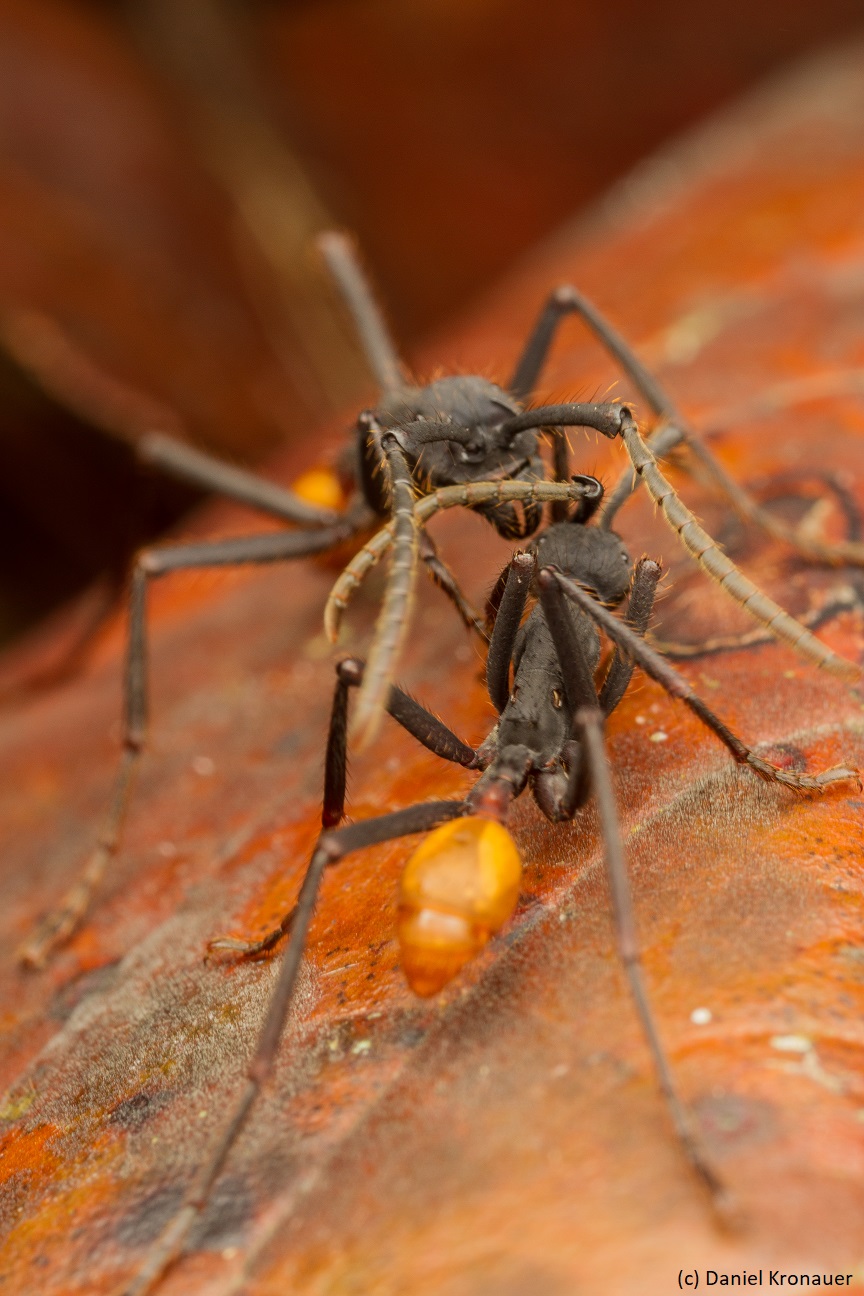 |
Arguably one of the most beautiful ants is this (relatively) gentle Amazonian giant, the army ant Eciton rapax. Interestingly, Eciton rapax is the only species in the genus that lacks the distinct soldier caste. Alta Floresta, Mato Grosso, Brazil. |
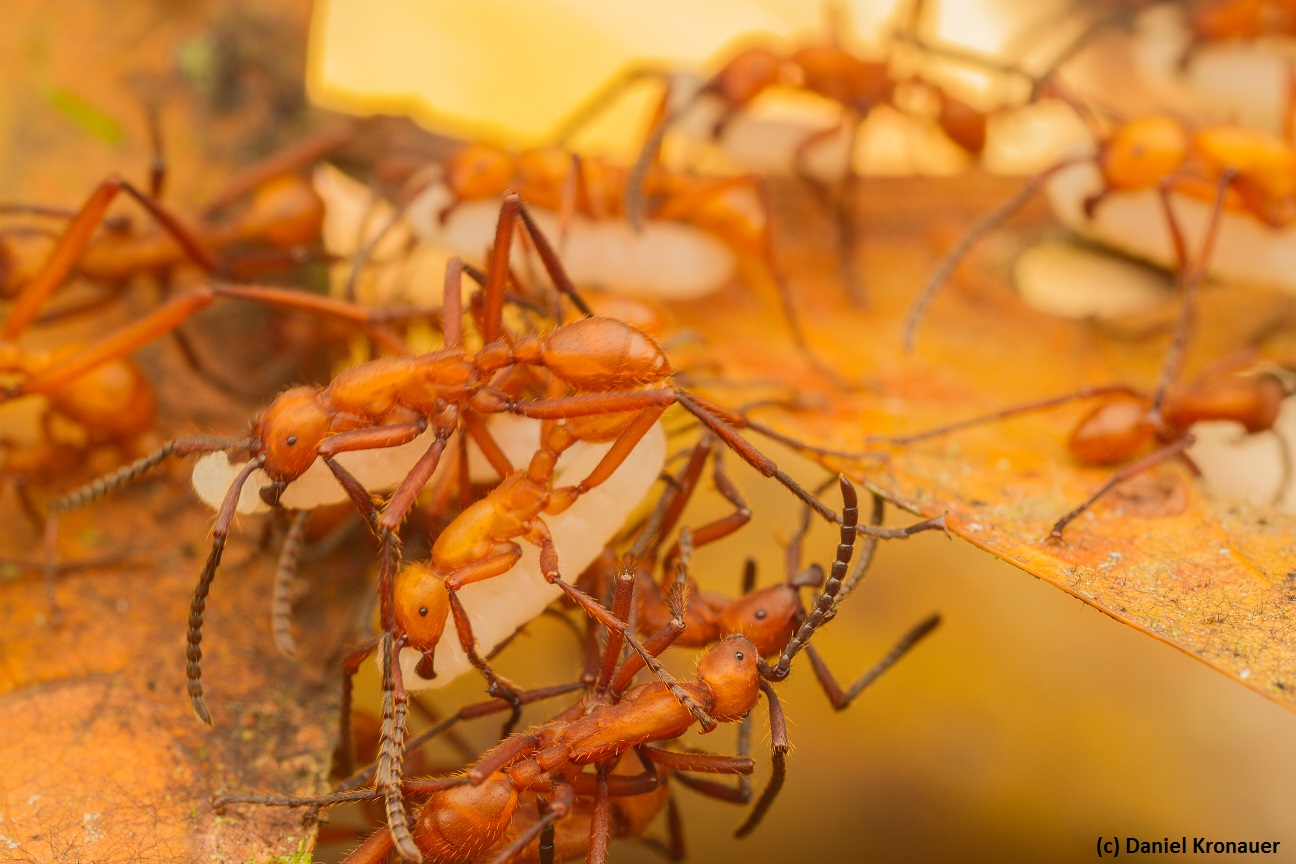 |
Eciton hamatum workers are carrying larvae during a colony emigration in the army ant-typical manner: with the mouthparts facing forward and up. La Selva Biological Station, Costa Rica. |
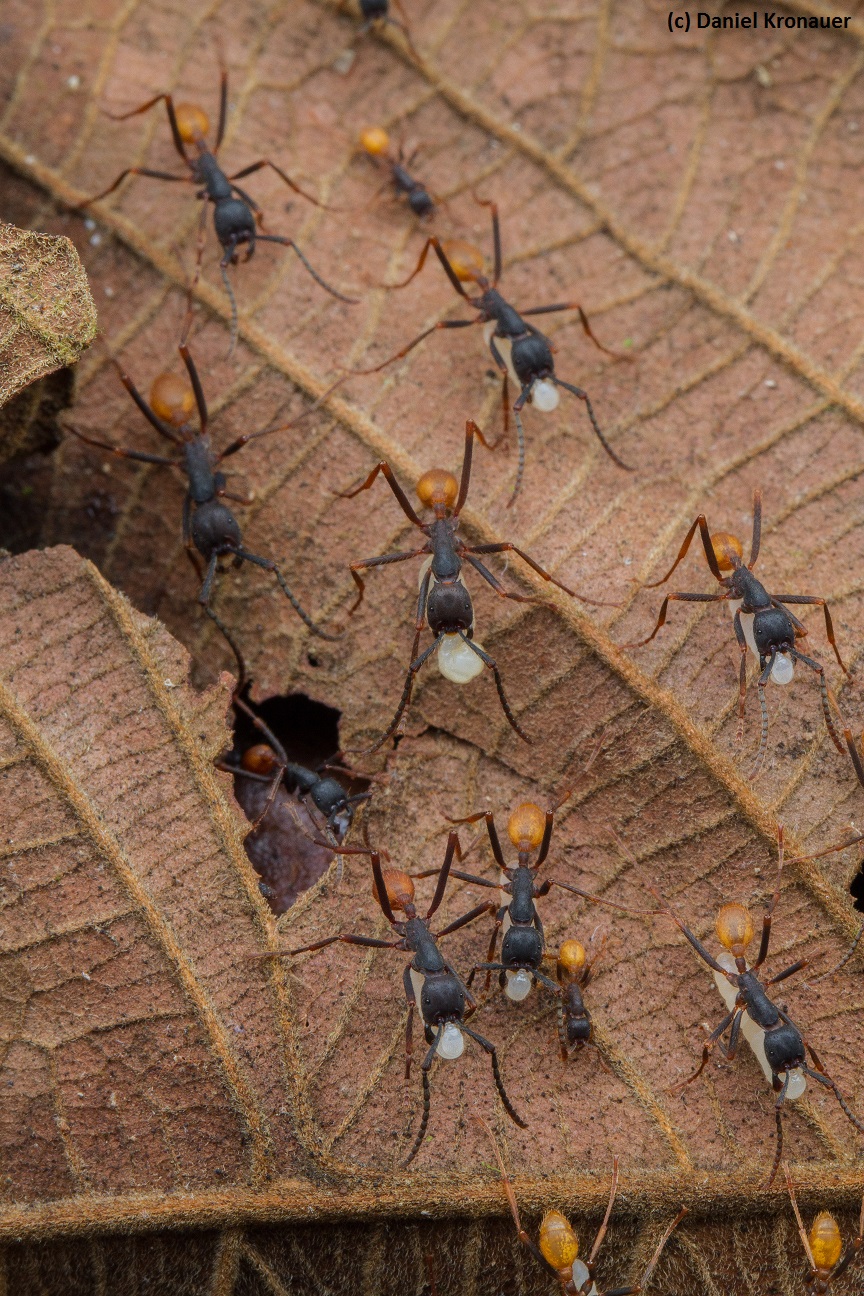 |
Eciton burchellii army ant workers are carrying larvae during a colony emigration. Note that the ants differ in tint – the lighter the ant’s behind, the younger it is. La Selva Biological Station, Costa Rica. |
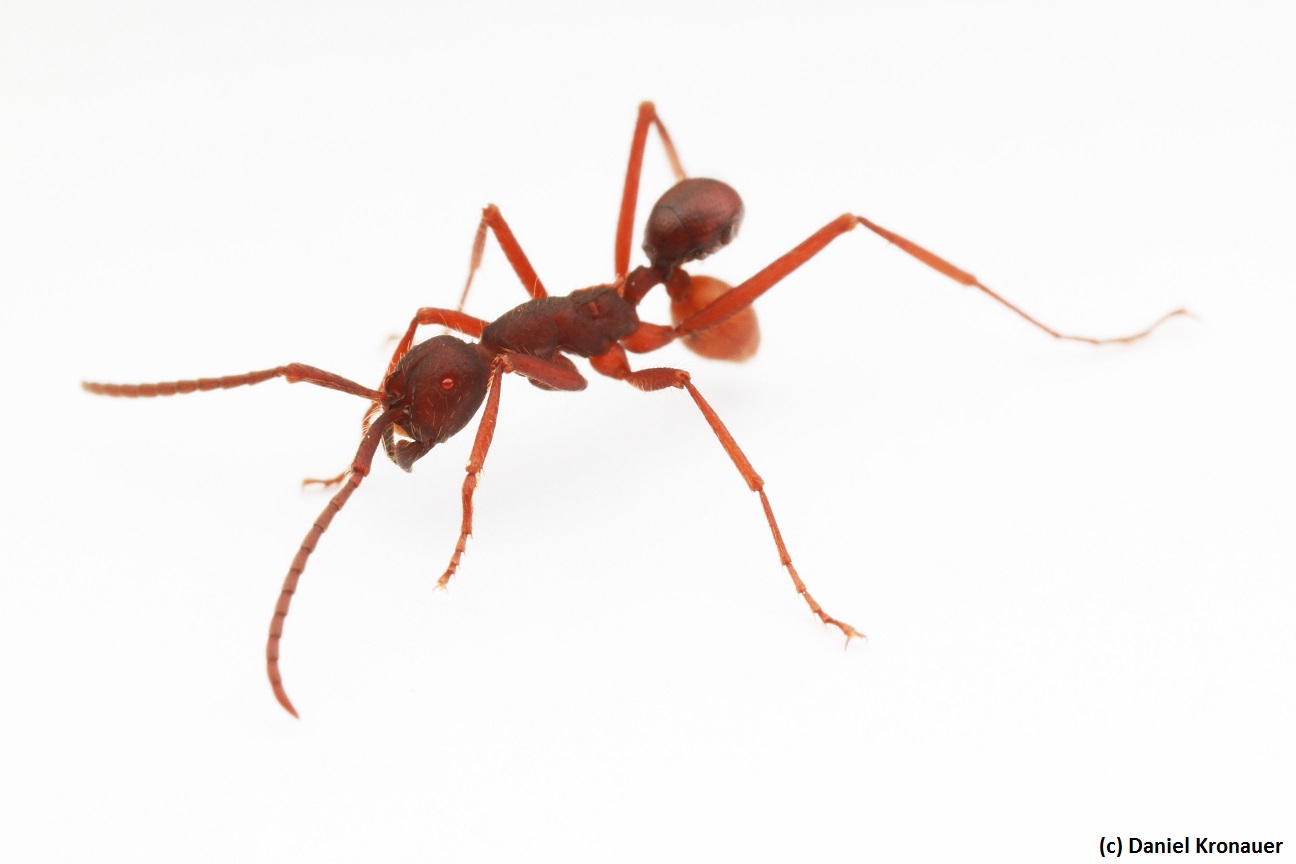 |
If you live inside army ant colonies as a social parasite, you have to follow the ants on their regular emigrations. The bareback riding clown beetle Nymphister kronaueri accomplishes this by attaching with its mandibles to the waist of its host, the army ant Eciton mexicanum. La Selva Biological Station, Costa Rica. |
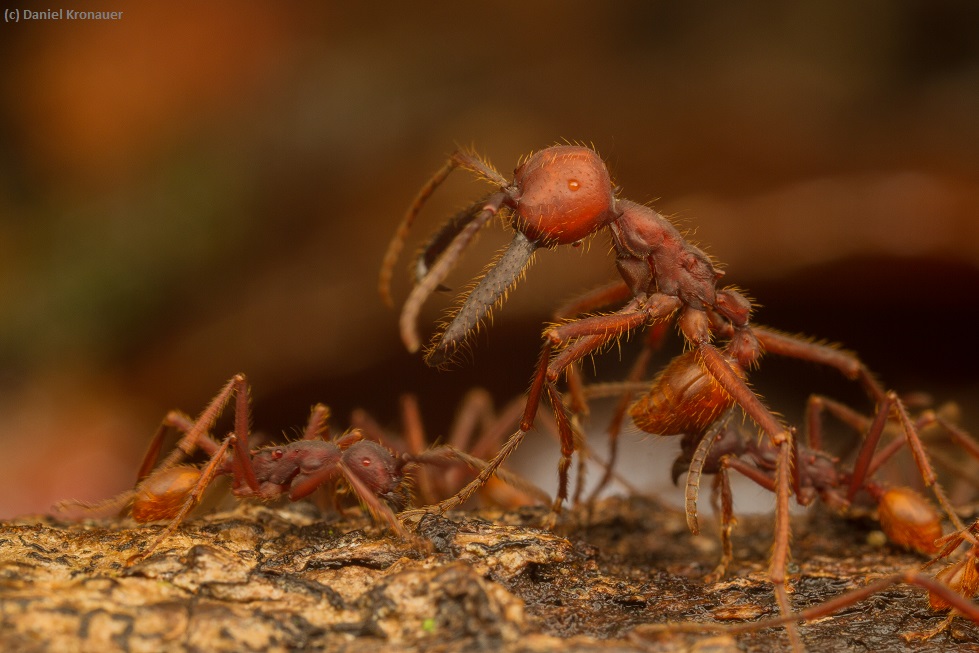 |
A soldier of Eciton mexicanum, the smallest among the Eciton species, is patrolling along an emigration column at La Selva Biological Station, Costa Rica. |
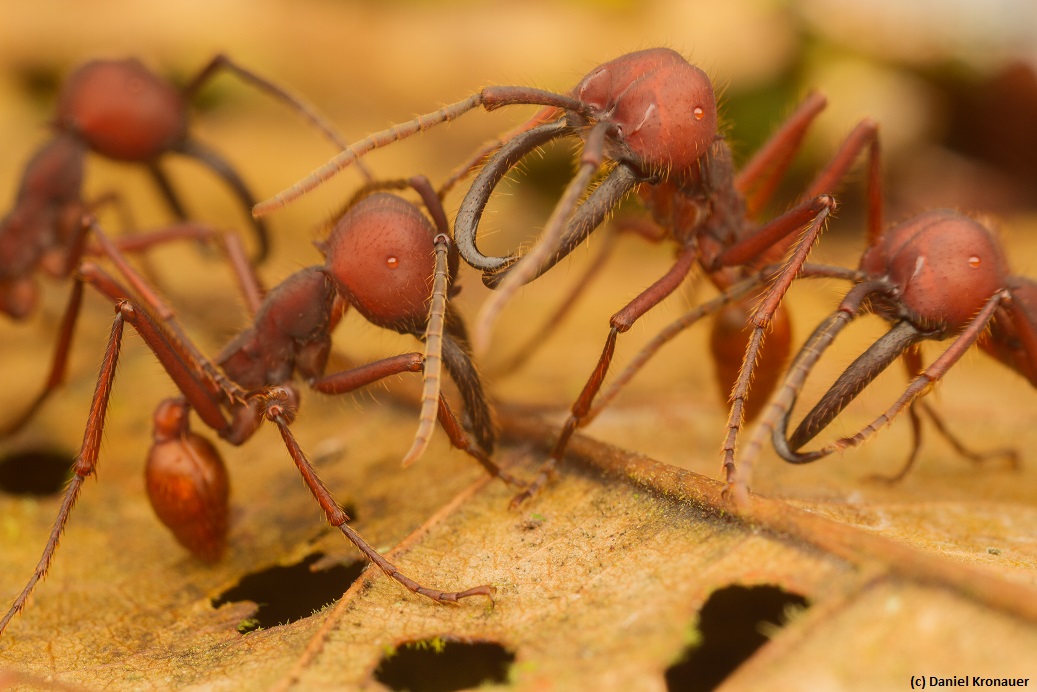 |
A gathering of Eciton vagans soldiers along a colony emigration column. La Selva Biological Station, Costa Rica. |
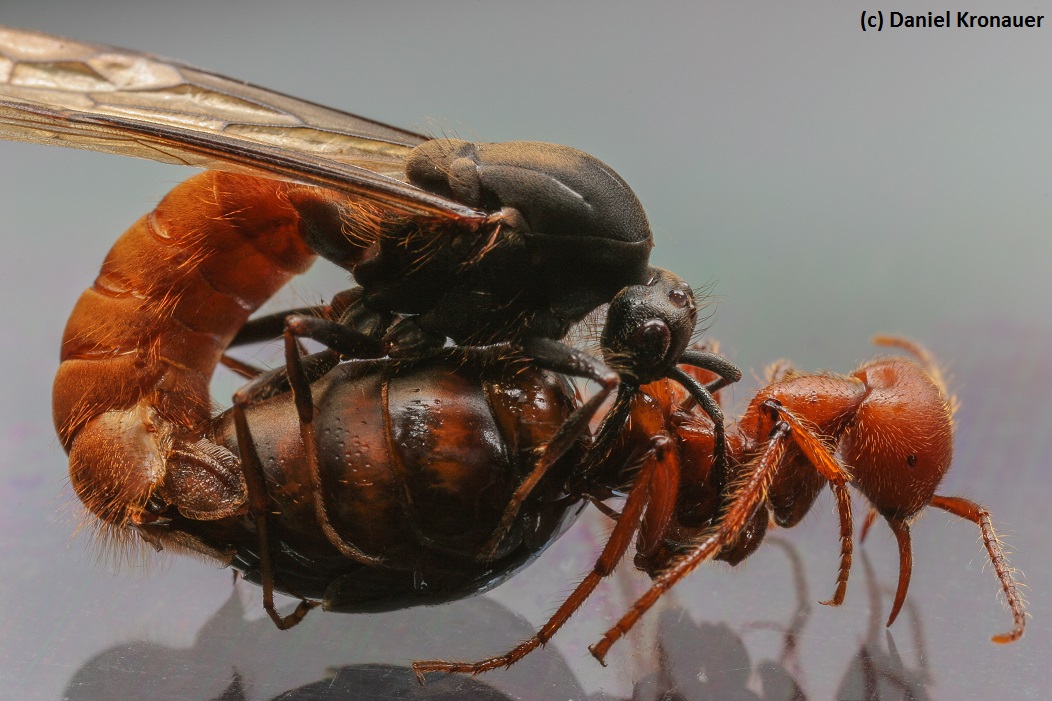 |
Observing army ants mating in the wild is essentially impossible, because the queens never leave the colony. It is, however, possible to stage matings in the lab. Here are a male and queen of Eciton burchellii in action. Rancho Grande Biological Station, Henri Pittier National Park, Venezuela. |
Other Ants
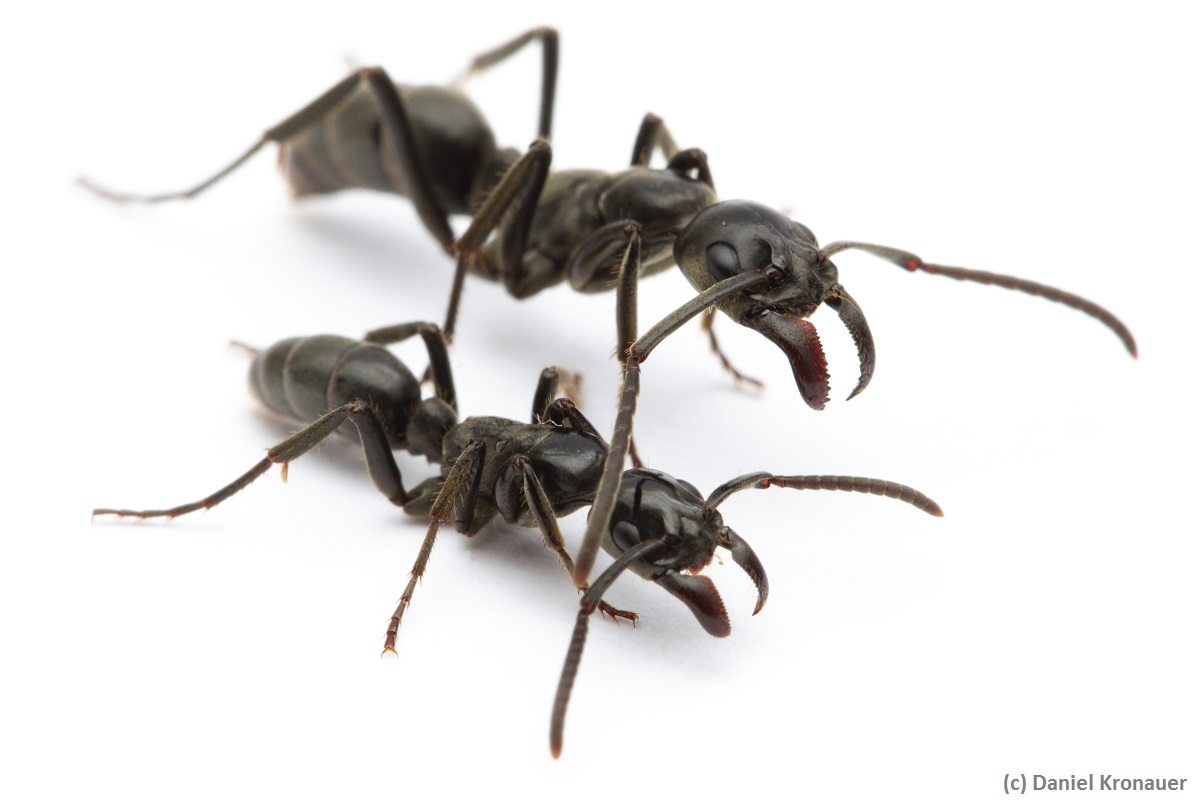 |
The ponerine ant Megaponera analis (also known as the Matabele ant) is a specialized termite hunter with army-ant like behavior. Small workers (bottom) enter termite galleries, retrieve one termite at a time, and pile the termites up on the ground outside. Their larger sisters (top) pick up the prey in bundles for transport. Mpala Research Centre, Kenya. |
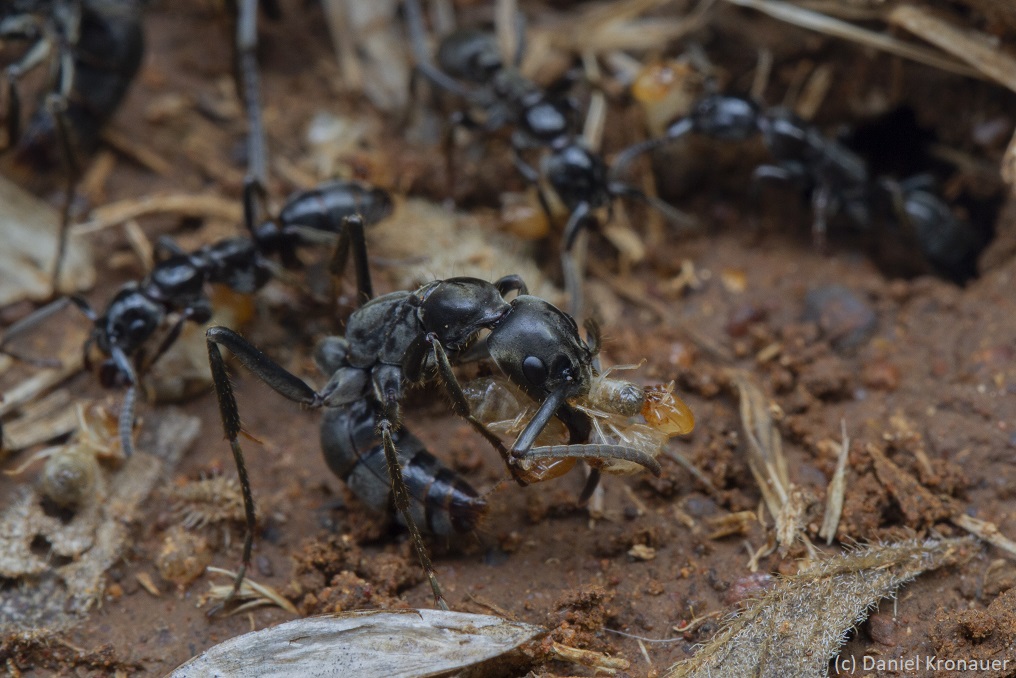 |
During a raid, small Megaponera analis workers enter the earthen galleries of termites and arrange the raided termites in neat piles (background). The large workers stuff the termites into their mandibles and carry them home in bundles (foreground). Mpala Research Centre, Kenya. Figure 2.22 |
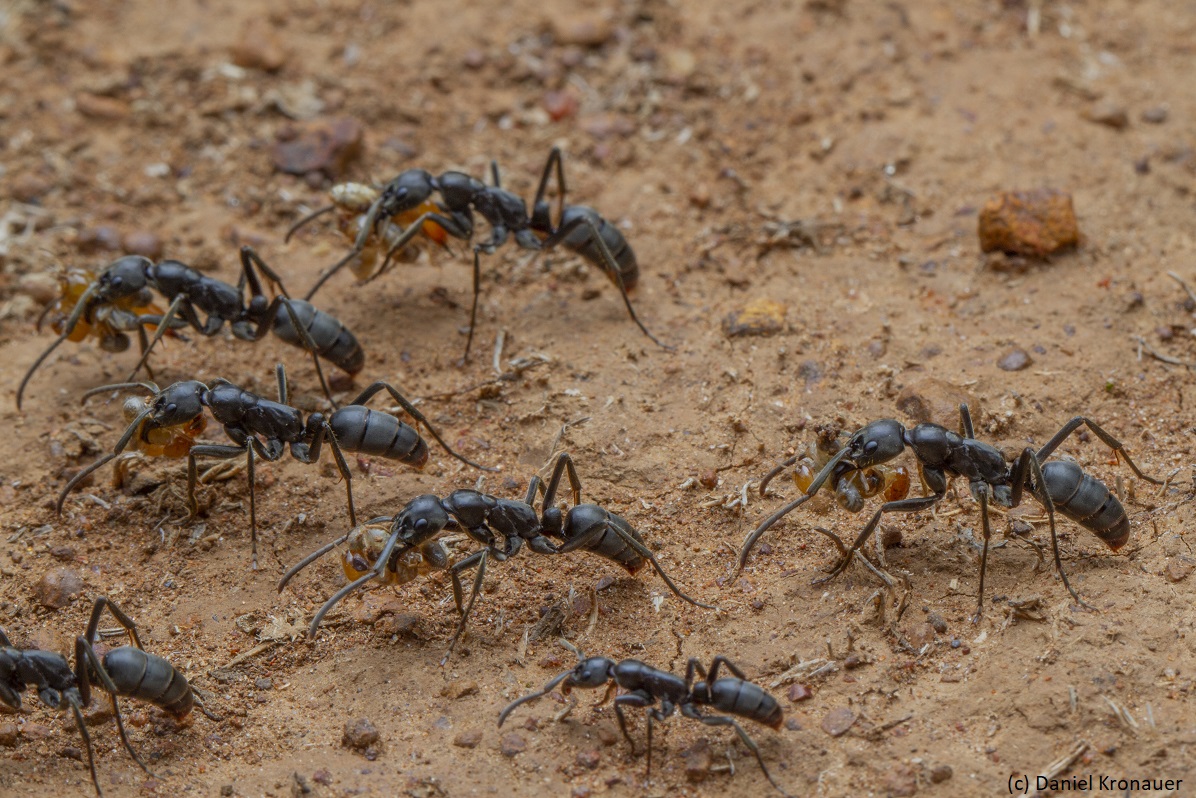 |
A successful Megaponera analis raid returns home, with workers carrying captured termites. Mpala Research Centre, Kenya. Figure 2.23 |
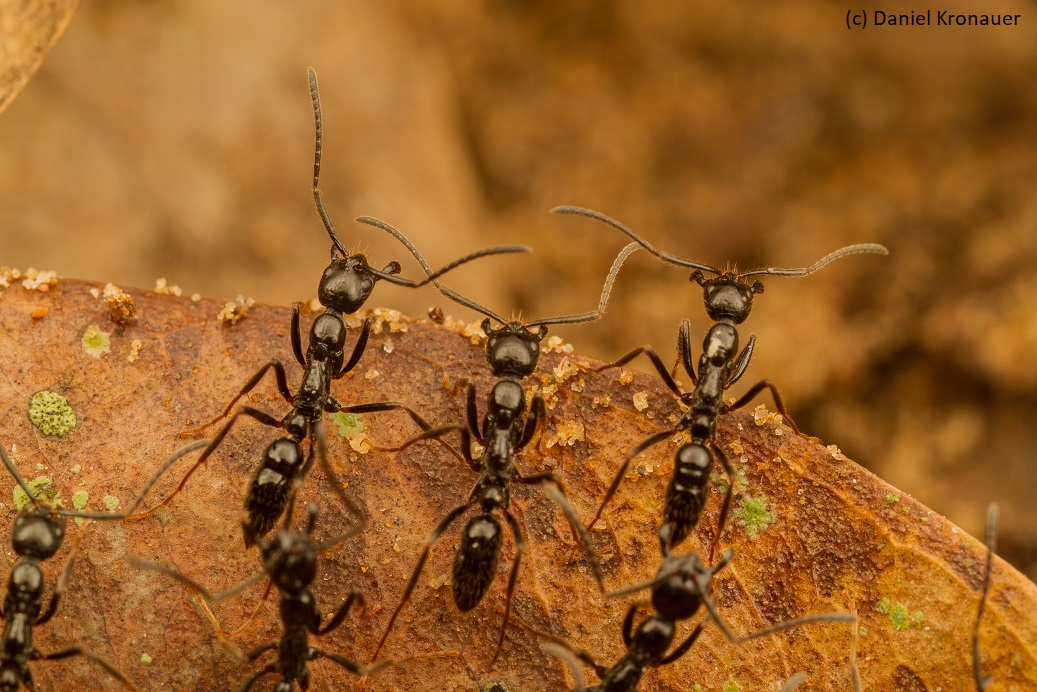 |
Closeup of a Leptogenys (probably L. diminuta) raiding party. This ponerine ant shows army ant-like behavior. Iron Range National Park, Australia. Figure 2.2 |